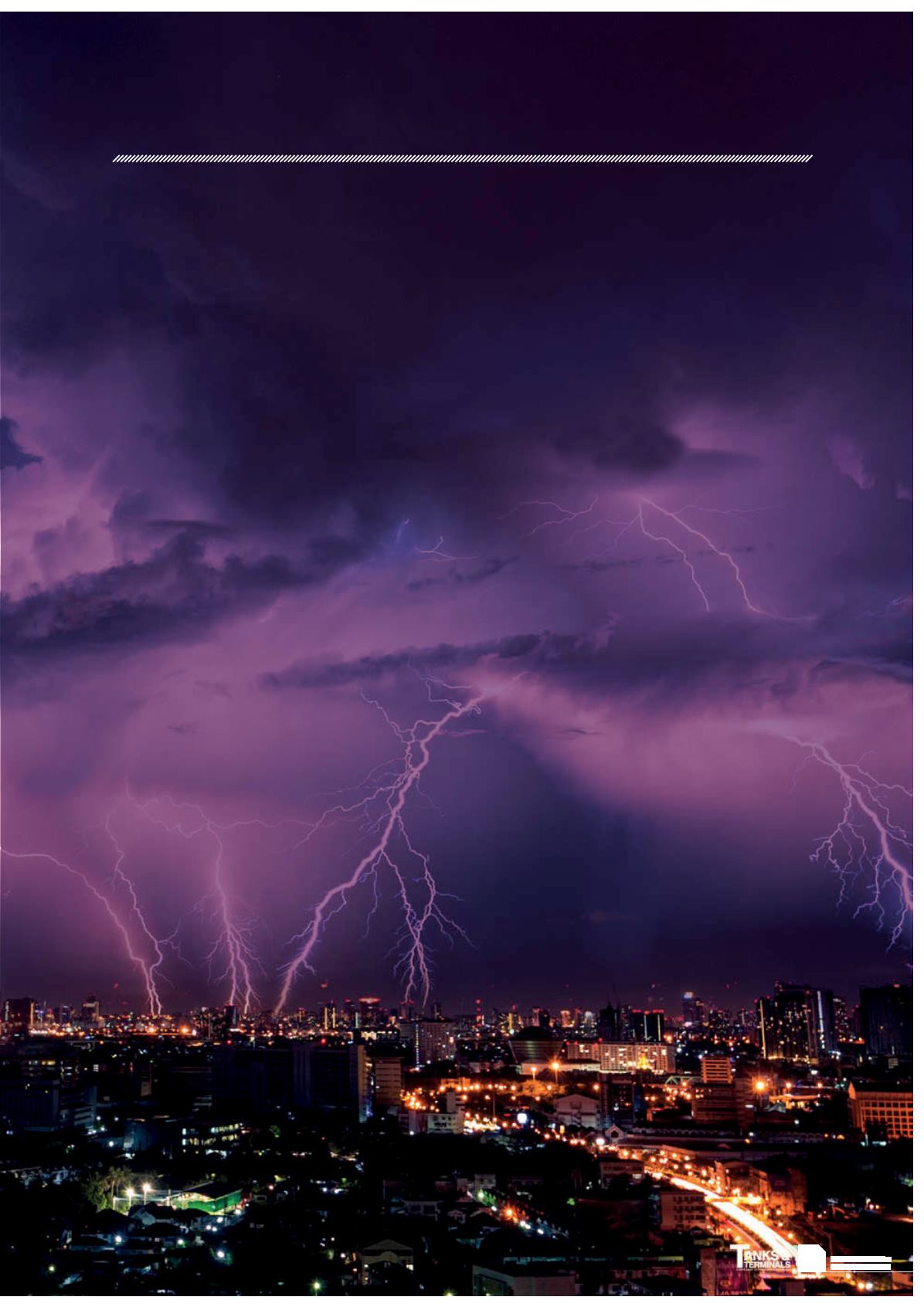
61
HYDROCARBON
ENGINEERING
L
ightning-related petroleum storage tanks fires are more
common than most people think. According to a review
of petroleum storage tank fires between 1951 and 2003,
the number of tank fires reported in the worldwide
media is in the range of 15 - 20 fires per year. The extent of the
tank fire incidents varies considerably, ranging from a rim seal
fire to multiple, simultaneous fully engaged tank fires. Of the
480 tank fire incidents reported in the media, about one third
have been attributed to lightning.
1
Another study, sponsored by
16 oil industry companies, found that 52 of 55 rim seal fires were
caused by lightning, and concluded that ‘lightning is the most
common source of ignition’.
2
Figure 1 shows a still taken from a video of a
lightning-related tank fire in an internal floating roof tank (FRT)
located in Wynnewood, Oklahoma.
3
Figure 2 shows a still taken
from a video of a lightning-related tank fire at a saltwater
disposal facility located in Greeley, Colorado.
4
In both cases,
lightning was the cause of ignition. In both cases, in addition to
the huge cost of lost product and damage to the physical plant,
there were also numerous large, incalculable costs, including
interruption of customer service; environmental harm;
firefighting, cleanup and rebuilding costs; EPA, OSHA and
regulatory fines and increased oversight; loss of community
goodwill, etc.
The fire at the Greeley facility was one of several
lightning-related fires at injection well facilities during the past
few years. Unfortunately, this is not a rare event. Oilfields in
several states have experienced lightning-related fires at
injection well facilities. Since 2013, there have been at least three
lightning-related fires at injection well facilities in North Dakota,
with four more in Texas and two more in Colorado.
5
Ignition mechanism: FRTs
Lightning strikes are characterised by very high stroke currents
arriving in a very brief amount of time. For example, an average
lightning strike delivers about 30 000 amps of electricity to the
ground within a fewmilliseconds. This current will flow across
the surface of the earth until the cell between the thundercloud
and earth is neutralised. The current will flow in all directions,
although the amount will vary in proportion to the paths of
lowest impedance.
The mostly likely strike location on an FRT is the top of the
rim or the gauge pole. However, lightning may endanger an FRT
if a stroke terminates on the roof, the shell, anything attached
to the roof or shell, such as the gauge pole, or a grounded
structure or the earth near the FRT. If lightning terminates on
any of these locations, or near an FRT, a portion of the total
lightning current will flow across the roof-shell interface. If
lightning should terminate on the tank shell, as illustrated in
Figure 3, sizable currents will flow across the roof-shell interface.
If lightning terminates near an FRT, either to the earth or to
a grounded structure, as illustrated in Figure 4, smaller currents
will flow across the roof-shell interface. In either case,
lightning-related currents will flow across the roof-shell
interface. If the impedance between the roof and shell is high,
arcing will occur across the seal interface.
A typical lightning stroke contains numerous components,
as shown in Figure 5. The fast component, or first return stroke
(Component A in the figure) is extremely brief, yet contains the
peak current. The long, slow component (Component C) lasts
much longer than either the fast Component A or the
transitional Component B and is responsible for vapour ignition.
Ignition mechanism: non-metal tanks
Non-metal and lined tanks are often used to store corrosive
byproducts, such as saltwater, from the hydraulic fracturing
process, because these byproducts are highly corrosive to steel.
Non-metal and lined tanks also exhibit significant
lightning-related risk due to their non-conductive nature.
Non-conductive tanks are being deployed with increasing
frequency in the Denver-Julesburg, Permian, Marcellus and other
oil shale regions. A non-conductive tank may be either a tank
constructed of a non-conductive material (such as fibreglass) or
a steel tank lined with epoxy or other non-conductive material.
They are considered non-conductive because, unlike steel tanks,
electrical charge cannot dissipate from the tanks’ contents to
ground via the tank.
As a working example, a common storage tank being used in
a petroleum-related field operation, such as one being used for
saltwater disposal, will be examined. If the tank is partially full,
the space above the fluid typically contains a combustible
vapour. In a grounded conventional steel tank, the conductive
steel allows for charge equalisation between the tank’s
contents, the tank itself and ground. However, for a
non-conductive or lined tank, there is no charge transfer and
equalisation, and so a charge differential between the
Joseph A. Lanzoni, Lightning Eliminators, USA,
outlines the lightning-related ignition
mechanisms for both floating roof and non-metal production tanks, and presents the
latest recommendations from various API and NFPA standards.


